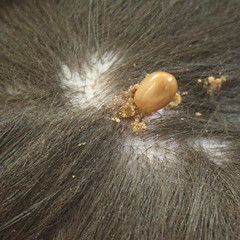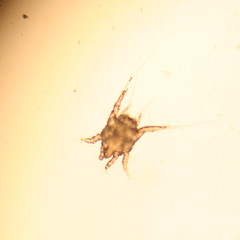A major aspect of preventive medicine for our four-legged friends involves parasite prevention. The types of parasites that our pets can get rob them of quality-of-life and some of these parasites can bother people, too. After the mild winter that we had here in northeast Ohio, we’re already seeing a bloom of parasites. This is consistent with the predictions of the parasite experts and the Companion Animal Parasite Council: 2012 is going to be a big year for parasites.
|
Because of this, I wanted to revisit these parasites, link back to what we’ve had to say about them in the past, and touch on the ways we can keep these parasites at bay for our dogs and cats. It’s about preventing disease in our pets as well as preventing disease in ourselves, our families and our community.
Let’s start with heartworm disease. Heartworms (pictured above left) are blood-borne parasites spread from animal to animal by mosquito. Heartworm disease is lifethreatening in cats, and certainly fatal in dogs without intervention. We offer a variety of heartworm preventive options, including ProHeart 6, Trifexis, Interceptor, Heartgard Plus, and Revolution.
The heartworm preventives listed above also protect against intestinal parasites (though they vary in their label claims). Intestinal parasites, such as roundworms (second photo), hookworms and whipworms, are spread fecal-orally, and puppies and kittens also can acquire them from their mothers in utero. These parasites are also zoonotic, meaning that animals can share them with people.
The above parasites are internal parasites. Fleas and Ticks are external parasites that bother our cats and dogs. Fleas (third photo), in particular, love to set up shop in our homes where they’re no longer subjet to freezes outside during the winter time. Once fleas gain a foothold in the home, it takes a long time to rid them from the environment. But… all flea cases and battles are winnable! If your pet is maintained on monthly flea control, fleas will not be able to establish themselves in your home.
Ticks (second photo from the bottom) aren’t as prolific in their reproduction, but they are persistent in their attack on hosts. Interestingly, tick populations have been increasing in Ohio over the last two years, and all signs point to a further increase this year. If ticks are in the environment, they want to find a host as soon as possible. Ticks are carriers of diseases such as Lyme and Ehrlichia.
Our treatment of choice for dogs at risk of fleas and ticks (and in this area, that’s most dogs) is Parastar Plus. In addition to its being one of the easier-to-apply topicals, it also kills fleas and ticks within an hour. For cats, our treatment of choice is Revolution for its broad-spectrum label claims.
Another external parasite that we run into from time to time is the ear mite (bottom photo). In addition to being disgusting, they also cause itchiness and discomfort for their hosts. Revolution does a wonderful job of addressing ear mites in cats, and other topical treatments, such as Milbemite, are available to get rid of these mites.
Finally, warbles are another seasonal parasite we see here and there in this part of Ohio. Young kittens and puppies, as well as senior animals that don’t keep up with grooming themselves tend to be the ones that present with warbles.






